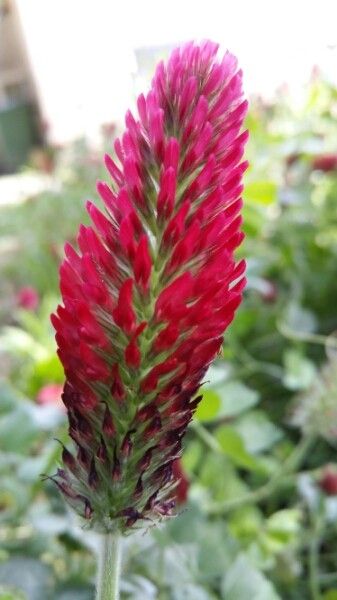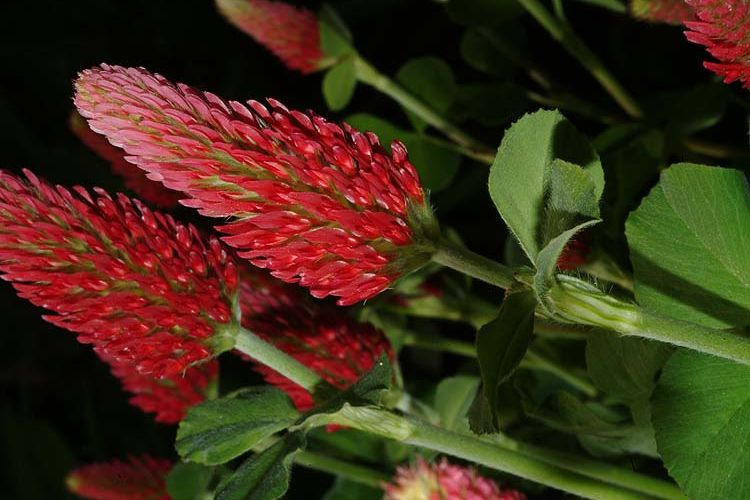Crimson Clover
trifolium incarnatum
Also known as: ["Scarlet Clover","Red Clover"]
Overview
An annual legume with striking crimson flowers, often used as a cover crop and forage plant.
Benefits & Perks
["long-flowering","disease resistant","wildlife attractant (bees, butterflies, birds)","drought tolerant"]
Botanical Classification
| Phylum: | Magnoliophyta |
| Class: | Magnoliopsida |
| Order: | Fabales |
| Family: | Fabaceae |
| Genus: | Trifolium |
| Botanical Name: | Trifolium incarnatum |
Plant Characteristics
Basic Information
- Category: Flowers
- Suitable Location: outdoor garden bed in full sun
- Suitable For:
- Is Weed: No
- Allergenicity: low
Environmental Needs
- Climate: {"temperatureRange":"5–30°C"}
- Hardiness: {"zones":"5–9"}
- Misting: rarely required, only if ambient humidity is very low
- Drainage: Moderate to fast-draining.
- Soil Type: Well-draining, loamy soil with added organic matter; can tolerate average garden soil.
Maintenance Level
- Maintenance Level: low
- Toughness Level: moderate
- Pruning Frequency: After flowering or every 2–3 months during active growth.
- Pruning Intensity: Moderate; remove up to one-third of the plant if overgrown.
Care Details
Ideal Sunlight Coverage:
Full sun (6–8 hours of direct sunlight daily); partial shade in hottest afternoon hours is beneficial during summer.
Sunlight Tolerance Tips:
Acclimate plants gradually to intense sunlight; protect from scorching by providing shade during peak heat; adjust placement based on indoor/outdoor conditions.
Care Requirements
Care Difficulty
easymoderate
Sunlight
full sun
Rotate plant for even light exposure; use sheer curtains to filter intense light; avoid sudden light changes.
Watering
every 5–7 days during active growth, reduce in winter
Water thoroughly until it drains from the bottom, allow soil to dry slightly between waterings, and avoid waterlogging.
Soil
well-drained, loamy soil with moderate organic content
pH: Slightly acidic to neutral (pH 6.0–7.0).
Avoid heavy clay soils; ensure good aeration; test pH if issues arise.
Temperature
Prefers cool to moderate temperatures (60–75°F or 15–24°C); tolerates cooler spring/fall conditions but avoids extreme heat.
Avoid placing near drafty windows; maintain consistent temperatures; adjust care based on seasonal shifts.
Fertilizing
every 4–6 weeks during growing season
Apply fertilizer after watering to prevent root burn; flush soil occasionally to prevent salt buildup; match fertilizer to plant's growth phase.
Propagation
Methods
Stem cuttings or seed; stem cuttings are faster and more reliable for home growers.
Step-by-Step Propagation Guide
- Take a 4–6 inch cutting below a node.
- Remove lower leaves.
- Dip in rooting hormone.
- Plant in medium.
- Maintain humidity.
Best Time: Spring or early summer when the plant is actively growing.
Environment
Warm (70–75°F or 21–24°C), high humidity (70–80%), and bright indirect light.
Medium
Well-draining potting mix with perlite or sand; can also use water propagation for stem cuttings.
Hormone
Rooting hormone is recommended to improve success rates.
Timeline
Roots typically form in 2–4 weeks; new growth may appear in 4–8 weeks.
Tools Needed
Pruning shears, rooting hormone, small pots, misting spray bottle, plastic bags or propagation dome.
Quick Tips
Use healthy, non-flowering stems; maintain consistent moisture; provide bottom heat if possible.
Pruning & Repotting
Pruning Guide
Method
Pinch back tips for bushiness; deadhead spent flowers; trim leggy stems to encourage compact growth.
Pruning Plan
Prune to maintain shape, encourage bushier growth, and remove spent flowers to promote reblooming.
Tools
Pruning shears, sharp scissors, gloves.
Checklist
Sterilize tools, prune during active growth, remove dead/damaged parts, shape evenly, clean up debris.
Repotting Guide
Best Season
Early spring before new growth begins.
Pot Size
Increase pot size by 1–2 inches in diameter; ensure good drainage.
Method
Remove plant gently, trim roots if necessary, place in a slightly larger pot with fresh soil, water lightly.
Suggestions
Repot every 1–2 years or when roots outgrow the pot; beneficial for rejuvenation and fresh soil.
Checklist
Choose appropriate pot, prepare new soil, inspect roots, handle plant carefully, water after repotting.
Advanced Care Tips
Watering Mastery
Watering Checklist
Check soil moisture, water deeply, ensure drainage, avoid wetting foliage, adjust for season.
How to Apply Water Properly
Water directly at the root zone, ensuring even moisture distribution, allowing excess water to drain, and watering in the morning to reduce evaporation.
Watering Schedule Tips
Water deeply once the top inch of soil feels dry, typically every 7–10 days during active growth, reducing frequency in winter to every 2–3 weeks.
Soil Improvement
Add compost or aged manure for fertility; mix perlite or sand for drainage; use mulch to retain moisture.
Temperature Stress Management
Signs of Temperature Issues
Wilting, leaf yellowing, stunted growth, or bud drop in response to extreme heat or cold.
Cold Stress
Low temperatures slow growth and may cause root damage or frost injury if below freezing.
Solution: Protect with frost cloth or mulch; move potted plants indoors; avoid sudden temperature drops.
Hot Stress
Excessive heat leads to wilting, leaf scorch, and reduced flowering due to water stress.
Solution: Provide shade during peak heat; increase watering frequency; use mulch to retain soil moisture.
Fertilizing Guide
Fertilizing Checklist
Check fertilizer type, dilute correctly, apply during active growth, avoid over-fertilization, flush periodically.
Fertilizing Method
Use balanced liquid fertilizer diluted to half strength every 4–6 weeks during spring and summer; avoid fertilizing in fall and winter.
Common Problems & Solutions
Toxicity Warning
Cats
Non-toxicTrifolium incarnatum is not toxic to cats. The plant is safe for feline consumption in typical amounts, though excessive intake may cause mild gastrointestinal issues.
⚠️ Symptoms:
🌿 Toxic Parts:
⚡ Toxic If:
if eaten
Dogs
Non-toxicScarlet clover is not considered toxic to dogs. The plant is often found in pastures and is generally safe for canine consumption in small to moderate amounts.
⚠️ Symptoms:
🌿 Toxic Parts:
⚡ Toxic If:
if eaten
Humans
Non-toxicTrifolium incarnatum, commonly known as scarlet clover, is generally considered non-toxic to humans. However, ingestion of large quantities of seeds or young plants may cause mild gastrointestinal discomfort due to the plant's high protein content.
⚠️ Symptoms:
🌿 Toxic Parts:
⚡ Toxic If:
if eaten in large quantities
Frequently Asked Questions
Q: Is Crimson Clover suitable for beginners?
A: Yes, it is easy to grow and requires minimal maintenance.
Q: Does Crimson Clover attract wildlife?
A: Yes, it is highly attractive to bees, butterflies, and birds.
Q: Can Crimson Clover be used as a cover crop?
A: Yes, it is commonly used to improve soil health and prevent erosion.
Quick Reference
| Family: | Fabaceae |
| Care: | easy |
| Light: | full sun |
| Water: | every 5–7 days during active |
Get Expert Care Tips
Download the Plantious app for personalized care reminders and plant identification!
Google Play App Store








